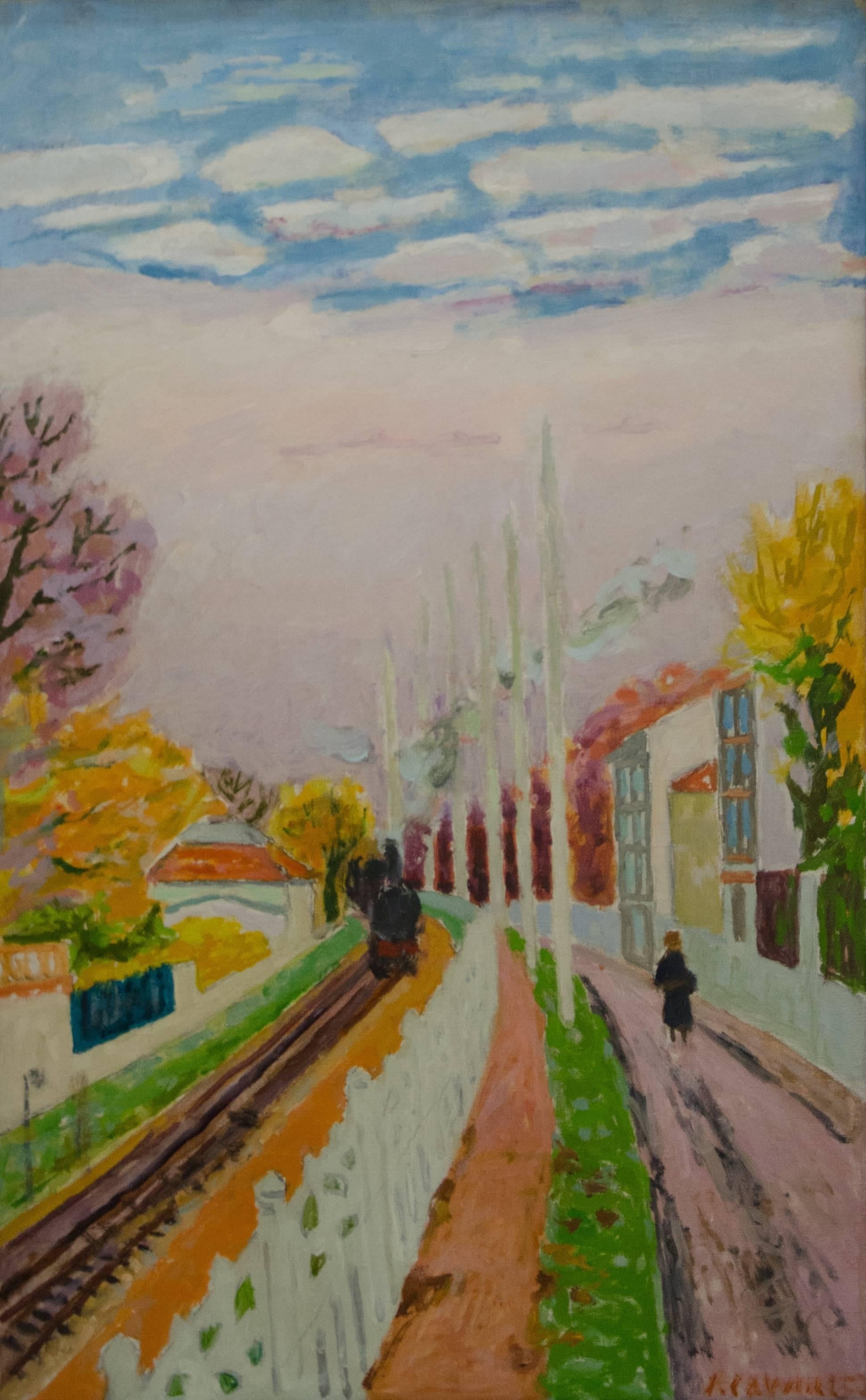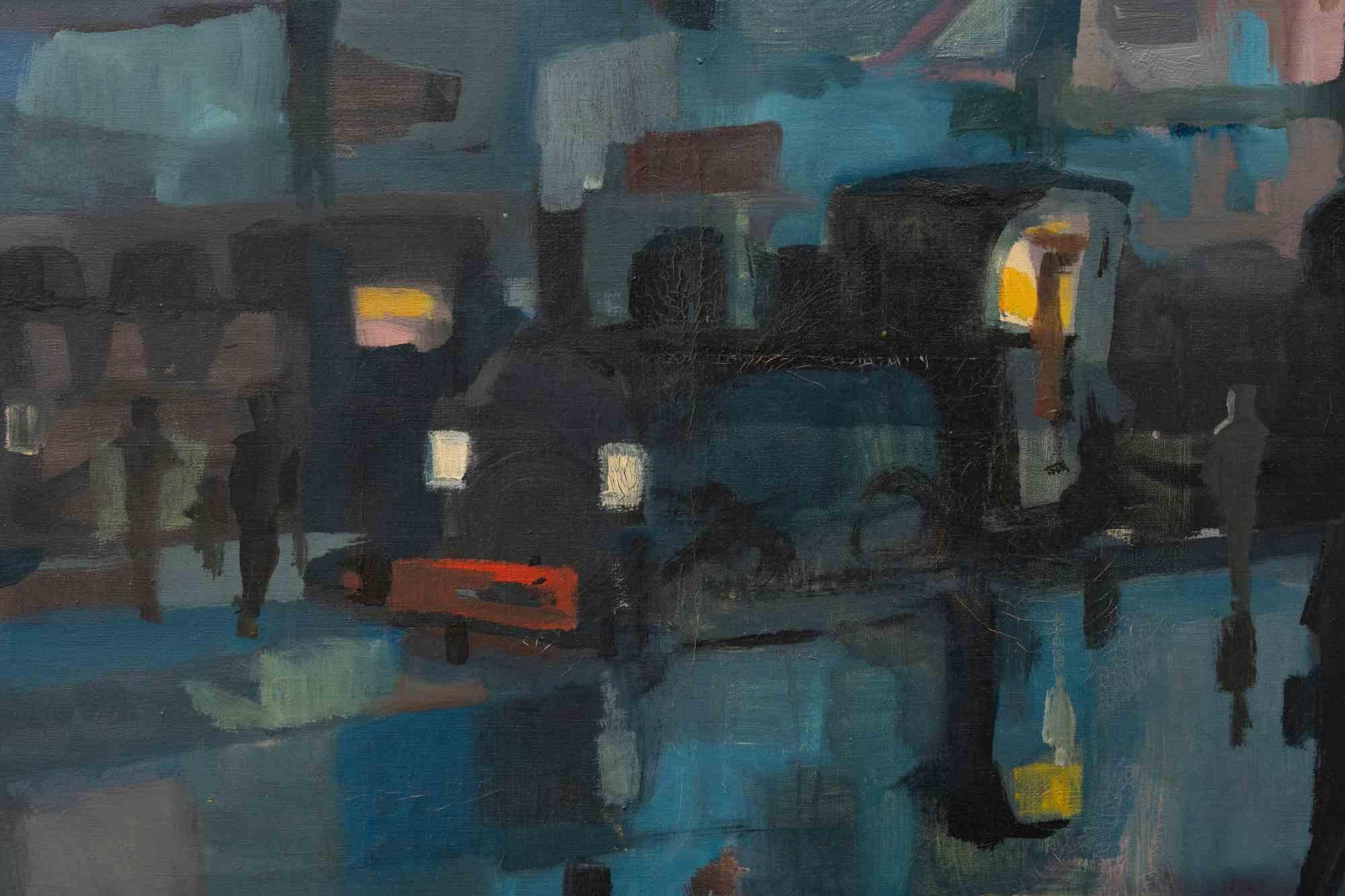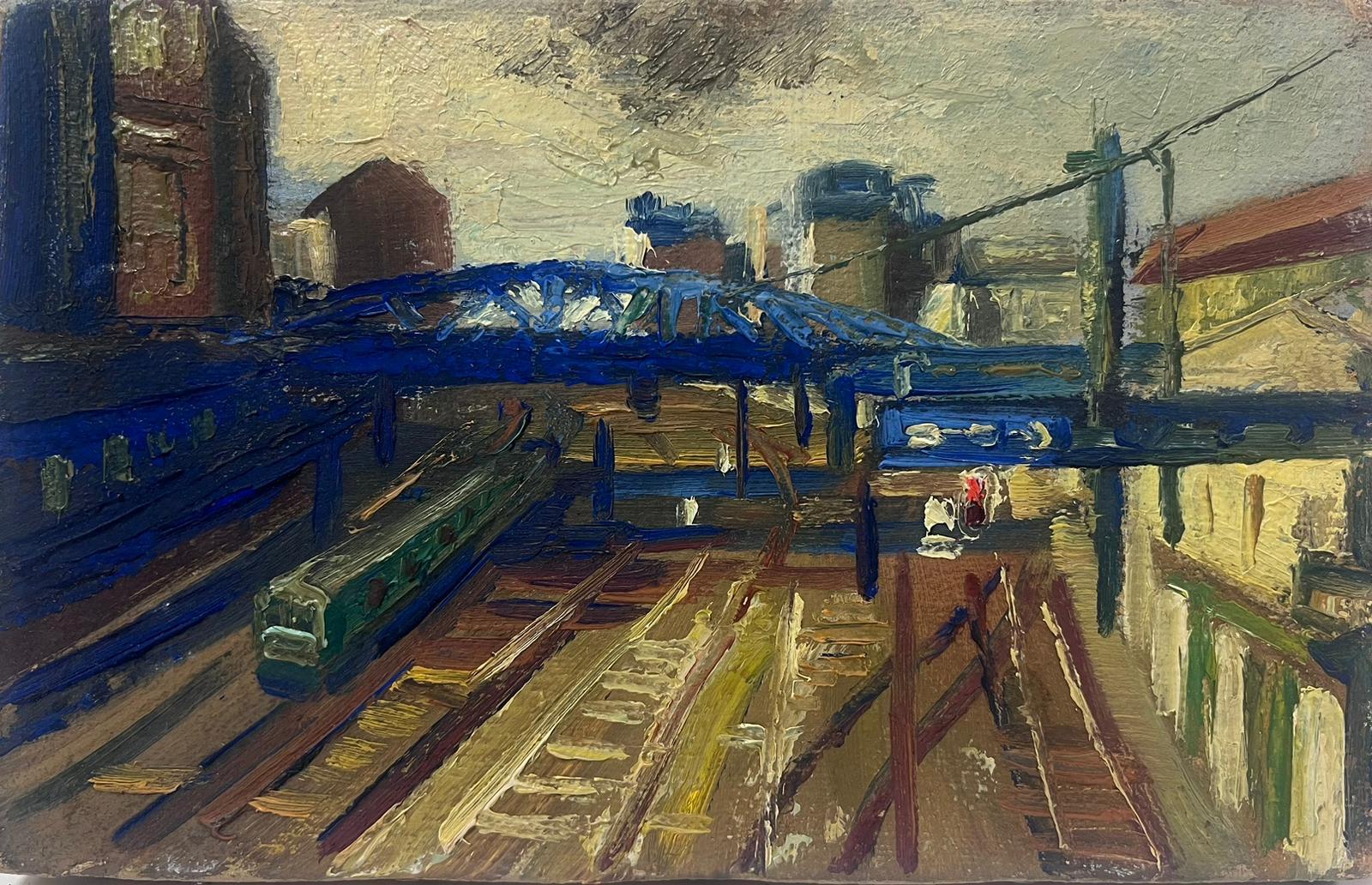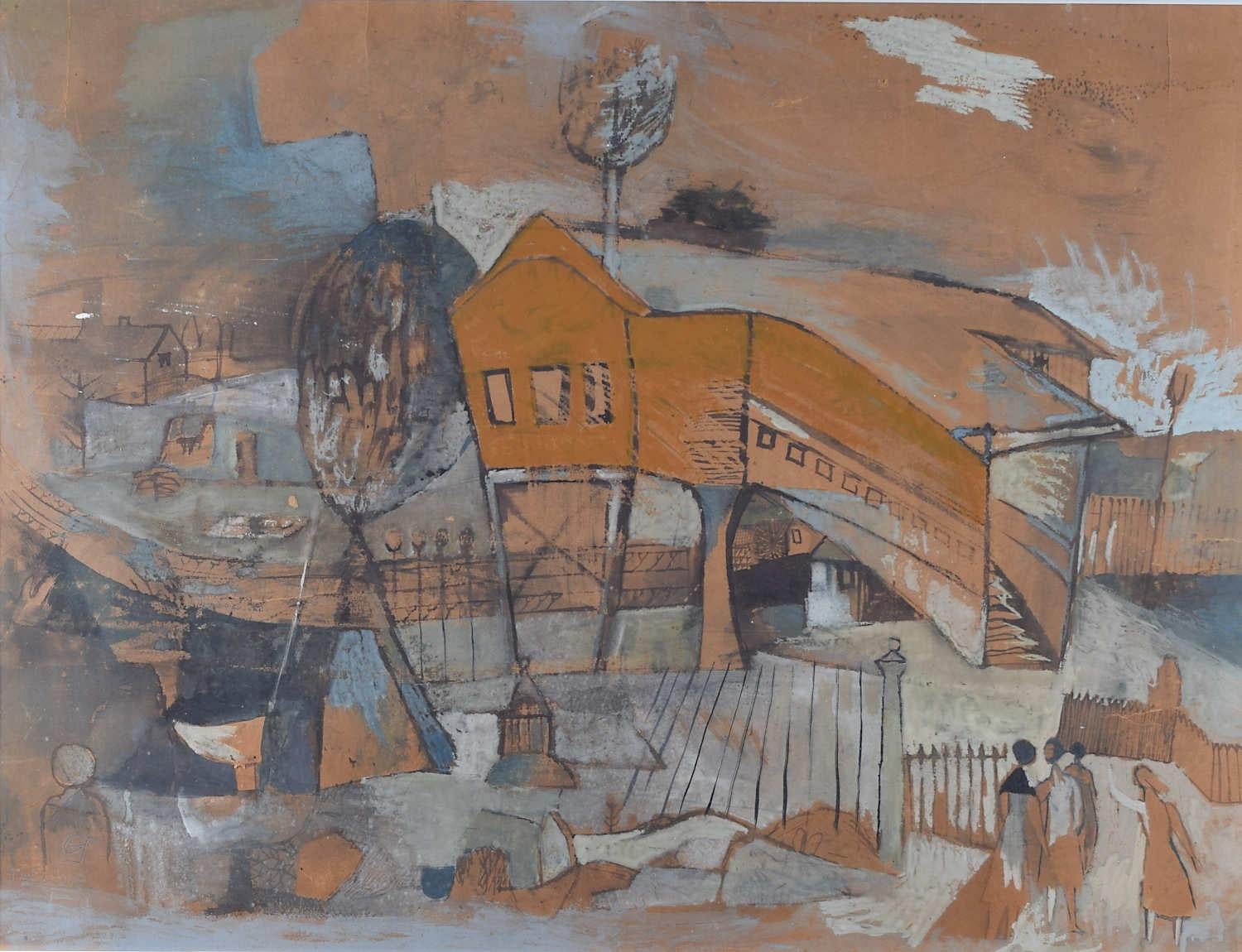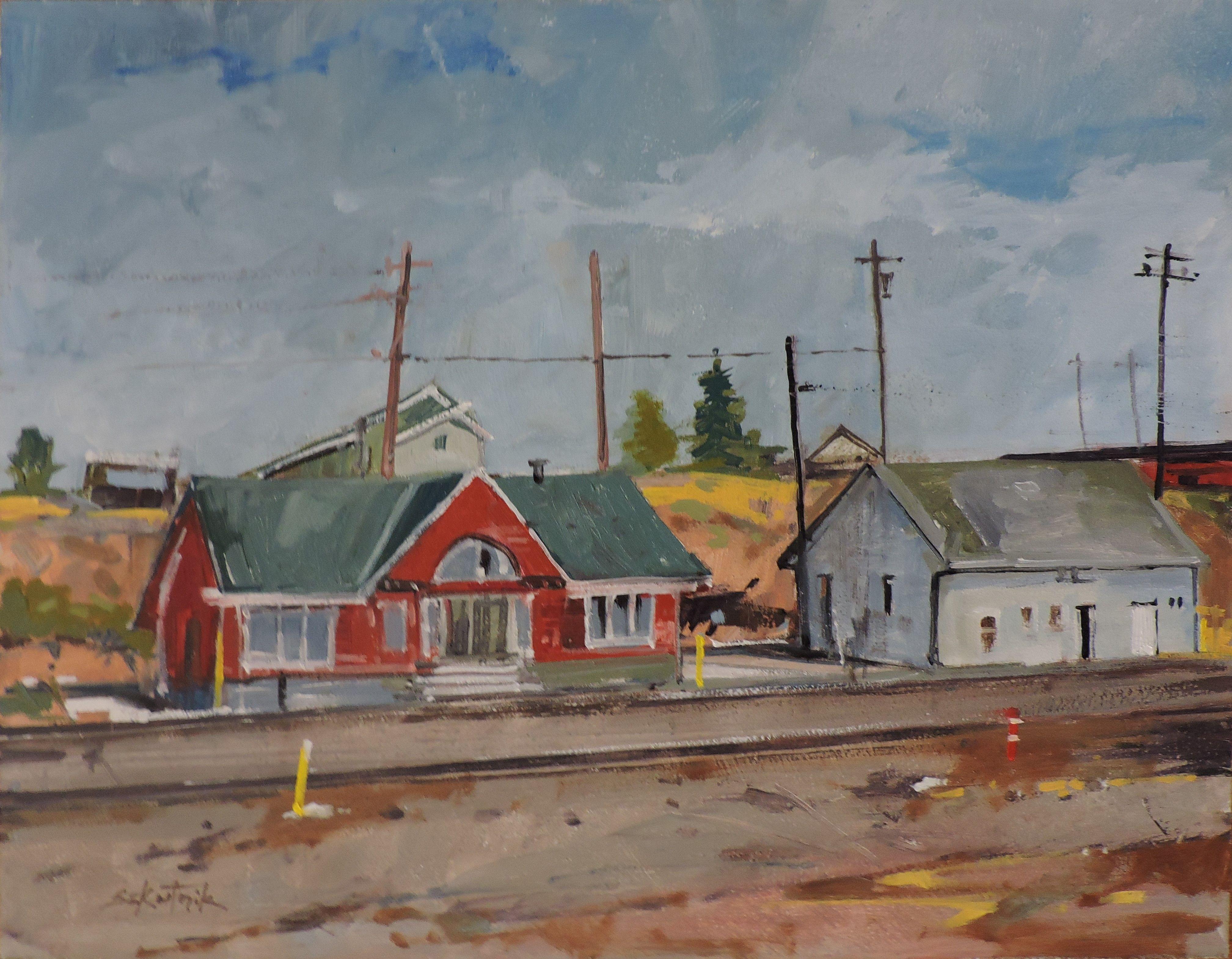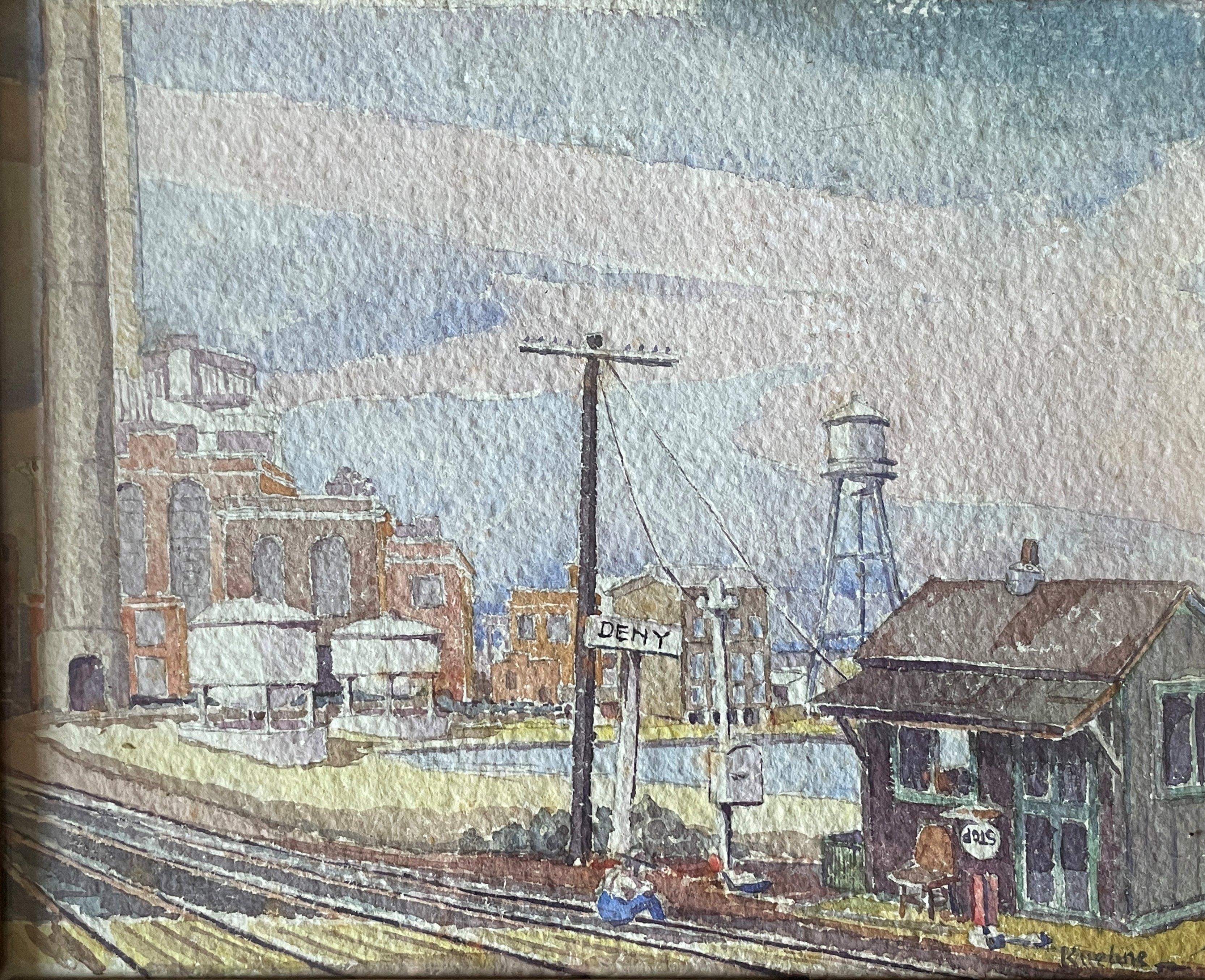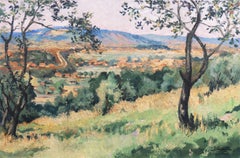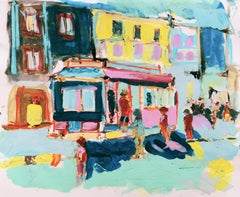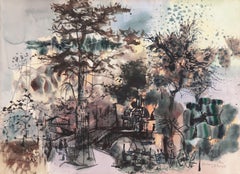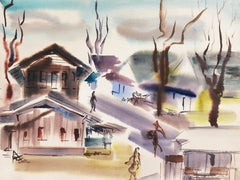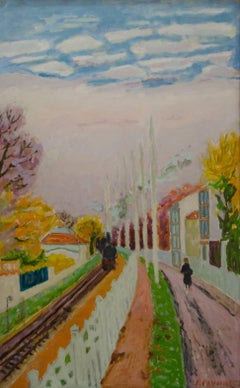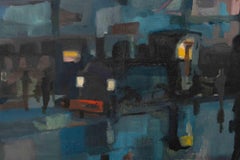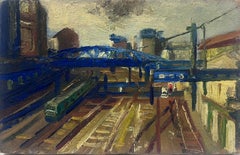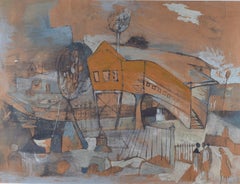Items Similar to 'Train Station, Geneva', Swiss Woman Expressionist Artist, Vienna Secession
Want more images or videos?
Request additional images or videos from the seller
1 of 15
Freida Wihelmine Doppler 'Train Station, Geneva', Swiss Woman Expressionist Artist, Vienna SecessionCirca 1890
Circa 1890
$1,462.50
$2,25035% Off
£1,116.61
£1,717.8635% Off
€1,290.24
€1,984.9835% Off
CA$2,053.07
CA$3,158.5735% Off
A$2,288.36
A$3,520.5635% Off
CHF 1,200.63
CHF 1,847.1235% Off
MX$27,944.65
MX$42,991.7835% Off
NOK 15,202.54
NOK 23,388.5235% Off
SEK 14,368.71
SEK 22,105.7135% Off
DKK 9,629.59
DKK 14,814.7535% Off
About the Item
Signature lower right, 'Dopplera' for Freida Wilhelmine Doppler (Swiss, 1870-1968) and painted circa 1890. (Also spelled Frieda Doppler.) Accompanied by label with title, 'Train Station, St. Gallen, Switzerland'.
A turn-of-the-century, Impressionist cityscape showing pedestrians at this Swiss train station. The artist's use of a fugitive and hazed color lends an Expressionist quality to the painting.
Freida Doppler was able to travel abroad, where she painted Arab markets in the late 1800s and exhibited with success, including at Innsbruck, Austria.
By the end of the nineteenth century, when mass-produced wallpapers became widely affordable, stenciling fell into artistic disrepute, degraded as “a plaything for amateurs or a labor-saving tool.” In contrast to its previous historical usage, the Böhm school elevated stenciling to a form of graphic printmaking in its own right, worthy of inclusion in Ver Sacrum. Ver Sacrum’s special September edition in 1902 was dedicated to Böhm school stencilwork and included designs by Henriette von Pokorny, Leontine Maneles, Frieda Doppler, Bettelheim, Harlfinger-Zakucka. and Podhajská, whose swan prints adorned the cover.
Reference:
The Female Secession: Art and the Decorative at the Viennese Women’s Academy, Megan Brandow-Faller, The Pennsylvania State University Press University Park, Pennsylvania; et al.
- Creator:Freida Wihelmine Doppler (1870 - 1968, Swiss)
- Creation Year:Circa 1890
- Dimensions:Height: 13 in (33.02 cm)Width: 16.25 in (41.28 cm)Depth: 0.13 in (3.31 mm)
- Medium:
- Period:
- Condition:paper laid down to card; age-toning, fading to colors, minor craquelure; unframed; shows well.
- Gallery Location:Santa Cruz, CA
- Reference Number:1stDibs: LU34413158402
About the Seller
5.0
Platinum Seller
Premium sellers with a 4.7+ rating and 24-hour response times
Established in 1982
1stDibs seller since 2013
742 sales on 1stDibs
Typical response time: 1 hour
- ShippingRetrieving quote...Shipping from: Santa Cruz, CA
- Return Policy
Authenticity Guarantee
In the unlikely event there’s an issue with an item’s authenticity, contact us within 1 year for a full refund. DetailsMoney-Back Guarantee
If your item is not as described, is damaged in transit, or does not arrive, contact us within 7 days for a full refund. Details24-Hour Cancellation
You have a 24-hour grace period in which to reconsider your purchase, with no questions asked.Vetted Professional Sellers
Our world-class sellers must adhere to strict standards for service and quality, maintaining the integrity of our listings.Price-Match Guarantee
If you find that a seller listed the same item for a lower price elsewhere, we’ll match it.Trusted Global Delivery
Our best-in-class carrier network provides specialized shipping options worldwide, including custom delivery.More From This Seller
View All'Steam Locomotive at Bry-Sur-Marne', Paris, Salon des Artistes Français, Benezit
Located in Santa Cruz, CA
Signed lower right, 'A. Delauzieres' for André Delauzieres (French, 1904-1941), dated 1936 and titled 'Bry-Sur-Marne'. Provenance: Collection of Ole...
Category
1930s Impressionist Landscape Paintings
Materials
Canvas, Oil
'San Francisco Trolley Car' Bay Area, California Expressionist, Stanford, Carmel
By Robert Canete
Located in Santa Cruz, CA
Signed lower right, 'Canete' for Robert Canete (American, born 1948) and painted circa 2000.
This Carmel artist studied with Vincent Rascon in the 1960'...
Category
21st Century and Contemporary Expressionist Landscape Paintings
Materials
Paper, Oil Pastel, Oil
'At the Park', Metropolitan Museum, NY MoMA, AIC, ASL, Whitney Museum, Toledo
Located in Santa Cruz, CA
Signed lower right, in graphite, 'Rainey Bennett' (American, 1907-1998) and dated 1958; titled, verso, 'Romantic Landscape' and accompanied by original ...
Category
1950s Expressionist Landscape Drawings and Watercolors
Materials
Paper, Ink, Watercolor
'Old Carmel Village', Woman Artist, San Francisco Art Association, Bay Area
By Dora Masters
Located in Santa Cruz, CA
Painted by Dora Masters (American, 1913-2003) circa 1960. Stamped verso with certification of authenticity. Acquired from the artist's son.
Dora Masters exhibited widely and with su...
Category
1960s Post-Impressionist Abstract Paintings
Materials
Watercolor, Laid Paper
'Sunset Landscape', Hamburg, Rivne, Volhynia, Rivne Museum
Located in Santa Cruz, CA
Signed lower right, 'G. Kosmiadi' for Georg Kosmiadi (Ukranian-German, 1886-1967) and dated, '66'; additionally signed verso, 'Georg Kosmiadi', inscribed with serial number and dated, '20/9/66'.
Georg Kosmiadi was a resident of Rivne before moving to Hamburg in 1940 where he worked as an art teacher. Kosmiadi exhibited at the Rivne Regional Museum and a regional art...
Category
1960s Abstract Impressionist Abstract Drawings and Watercolors
Materials
Paper, Gouache
'Fort Bragg Lumber Mill', Woman Artist, California Post-Impressionist
By Muriel Backman
Located in Santa Cruz, CA
Signed lower left "M. Backman" for Muriel Durgin Backman. Titled verso "Union Lumber Co., Fort Bragg- Mendocino, Ca" and painted circa 1955.
A moody, mid-c...
Category
1950s Modern Landscape Paintings
Materials
Watercolor, Gouache, Handmade Paper
$1,592 Sale Price
35% Off
You May Also Like
Le Train de Banlieue
By Jules Cavailles
Located in Rancho Santa Fe, CA
Listed in the Jules Cavailles archives as # L_13_011.
Signed and titled verso.
Jules Cavailles was a well-known, highly regarded, and versatile French painter. He worked in oils, g...
Category
Mid-20th Century Modern Landscape Paintings
Materials
Canvas, Oil
Price Upon Request
Train Station - Oil Paint by Eliano Fantuzzi - 1953
By Eliano Fantuzzi
Located in Roma, IT
Oil on canvas realized by Fantuzzi in 1952.
Hand signed lower left and on rear.
Category
1950s Modern Figurative Paintings
Materials
Oil
1950s French Post Impressionist Oil Paris Train Station with Train on Track
By Josine Vignon
Located in Cirencester, Gloucestershire
Josine Vignon (French 1922-2022) ...
Category
Mid-20th Century Impressionist Landscape Paintings
Materials
Oil
Gwyneth Johnstone: 'The Railway Bridge' Modern British Art watercolour
By Gwyneth Johnstone
Located in London, GB
To see our other Modern British Art, scroll down to "More from this Seller" and below it click on "See all from this Seller" - or send us a message if you cannot find the artist you want.
Gwyneth...
Category
Mid-20th Century Modern Landscape Drawings and Watercolors
Materials
Mixed Media
Gramby Station, Painting, Oil on Wood Panel
By Richard Szkutnik
Located in Yardley, PA
original oil on panel paint in Gramby, Colorado :: Painting :: Impressionist :: This piece comes with an official certificate of authenticity signed by the artist :: Ready to Hang: N...
Category
21st Century and Contemporary Impressionist Paintings
Materials
Oil
"Train Station, " Max Kuehne, Industrial City Scene, American Impressionism
By Max Kuehne
Located in New York, NY
Max Kuehne (1880 - 1968)
Train Station, circa 1910
Watercolor on paper
8 1/4 x 10 1/4 inches
Signed lower right
Provenance:
Private Collection, Illinois
Max Kuehne was born in Halle, Germany on November 7, 1880. During his adolescence the family immigrated to America and settled in Flushing, New York. As a young man, Max was active in rowing events, bicycle racing, swimming and sailing. After experimenting with various occupations, Kuehne decided to study art, which led him to William Merritt Chase's famous school in New York; he was trained by Chase himself, then by Kenneth Hayes Miller. Chase was at the peak of his career, and his portraits were especially in demand. Kuehne would have profited from Chase's invaluable lessons in technique, as well as his inspirational personality. Miller, only four years older than Kuehne, was another of the many artists to benefit from Chase's teachings. Even though Miller still would have been under the spell of Chase upon Kuehne's arrival, he was already experimenting with an aestheticism that went beyond Chase's realism and virtuosity of the brush. Later Miller developed a style dependent upon volumetric figures that recall Italian Renaissance prototypes.
Kuehne moved from Miller to Robert Henri in 1909. Rockwell Kent, who also studied under Chase, Miller, and Henri, expressed what he felt were their respective contributions: "As Chase had taught us to use our eyes, and Henri to enlist our hearts, Miller called on us to use our heads." (Rockwell Kent, It's Me O Lord: The Autobiography of Rockwell Kent. New York: Dodd, Mead and Co., 1955, p. 83). Henri prompted Kuehne to search out the unvarnished realities of urban living; a notable portion of Henri's stylistic formula was incorporated into his work.
Having received such a thorough foundation in art, Kuehne spent a year in Europe's major art museums to study techniques of the old masters. His son Richard named Ernest Lawson as one of Max Kuehne's European traveling companions. In 1911 Kuehne moved to New York where he maintained a studio and painted everyday scenes around him, using the rather Manet-like, dark palette of Henri.
A trip to Gloucester during the following summer engendered a brighter palette. In the words of Gallatin (1924, p. 60), during that summer Kuehne "executed some of his most successful pictures, paintings full of sunlight . . . revealing the fact that he was becoming a colorist of considerable distinction." Kuehne was away in England the year of the Armory Show (1913), where he worked on powerful, painterly seascapes on the rocky shores of Cornwall. Possibly inspired by Henri - who had discovered Madrid in 1900 then took classes there in 1906, 1908 and 1912 - Kuehne visited Spain in 1914; in all, he would spend three years there, maintaining a studio in Granada. He developed his own impressionism and a greater simplicity while in Spain, under the influence of the brilliant Mediterranean light. George Bellows convinced Kuehne to spend the summer of 1919 in Rockport, Maine (near Camden). The influence of Bellows was more than casual; he would have intensified Kuehne's commitment to paint life "in the raw" around him.
After another brief trip to Spain in 1920, Kuehne went to the other Rockport (Cape Ann, Massachusetts) where he was accepted as a member of the vigorous art colony, spearheaded by Aldro T. Hibbard. Rockport's picturesque ambiance fulfilled the needs of an artist-sailor: as a writer in the Gloucester Daily Times explained, "Max Kuehne came to Rockport to paint, but he stayed to sail." The 1920s was a boom decade for Cape Ann, as it was for the rest of the nation. Kuehne's studio in Rockport was formerly occupied by Jonas Lie.
Kuehne spent the summer of 1923 in Paris, where in July, André Breton started a brawl as the curtain went up on a play by his rival Tristan Tzara; the event signified the demise of the Dada movement. Kuehne could not relate to this avant-garde art but was apparently influenced by more traditional painters — the Fauves, Nabis, and painters such as Bonnard. Gallatin perceived a looser handling and more brilliant color in the pictures Kuehne brought back to the States in the fall. In 1926, Kuehne won the First Honorable Mention at the Carnegie Institute, and he re-exhibited there, for example, in 1937 (Before the Wind). Besides painting, Kuehne did sculpture, decorative screens, and furniture work with carved and gilded molding. In addition, he designed and carved his own frames, and John Taylor Adams encouraged Kuehne to execute etchings. Through his talents in all these media he was able to survive the Depression, and during the 1940s and 1950s these activities almost eclipsed his easel painting. In later years, Kuehne's landscapes and still-lifes show the influence of Cézanne and Bonnard, and his style changed radically.
Max Kuehne died in 1968. He exhibited his work at the National Academy of Design, the Art Institute of Chicago, the Carnegie Institute in Pittsburgh, the Memorial Art Gallery of the University of Rochester, and in various New York City galleries. Kuehne's works are in the following public collections: the Detroit Institute of Arts (Marine Headland), the Whitney Museum (Diamond Hill...
Category
1910s American Impressionist Landscape Drawings and Watercolors
Materials
Paper, Watercolor
More Ways To Browse
Geneva Switzerland
Antique Trains
Geneva Painting
Female Expressionist Artist
Nineteenth Century Drawings
Swan Print
Swan Landscape
Antique Painting Tools
Train Station Painting
Antique Drawing Tools
Arab Drawing
Antique Swan Painting
Antique Train Station
Antique Landscape Wallpaper
Justin Faivre
Louis Vuitton Recto Verso Black
Maria Ada Gianni
Nestor Fruge
